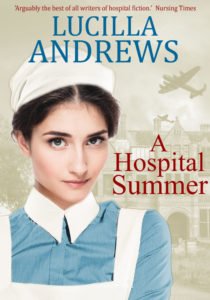Florence, Cherry, Lucilla and me by Kate Blackadder
 Kate Blackadder looks back fondly at the real and fictional nurses whose adventures she has enjoyed.
Kate Blackadder looks back fondly at the real and fictional nurses whose adventures she has enjoyed.
As a ten-year-old, after reading a book about Florence Nightingale, I wanted to be a nurse. That version of her story ignored what I now know to be the ugly facts of Crimean field hospitals and instead dwelt on a figure wearing a pure white dress who glided between rows of pristine beds, the lamp she held casting a golden glow over her adoring patients.
After further delves into the school library, however, I abandoned my putative nursing career and aspired in turn to be a Wren, a ballet dancer, an air stewardess, a reporter and an intrepid explorer – and other callings that in retrospect I would also be deeply unsuited for.
But I’ve never stopped enjoying being a nurse – vicariously.
After the lady with the lamp, there was Jean Becomes a Nurse by Yvonne Trewin SRN. ‘In it [this book], the girl, interested in such a career … will be immeasurably aided in making her decision by experiencing the real hospital atmosphere which the author has so truly reproduced.’
Then I discovered Cherry Ames, American heroine of twenty-seven mysteries with a medical setting. There were Cherry Ames Annuals as well – and even a Nursing Game and Cherry Ames’ Book of First Aid and Home Nursing.
Cherry went from being Cherry Ames: Student Nurse to Army Nurse, Cruise Nurse, Mountaineer Nurse, Dude Ranch Nurse, Island Nurse, Camp Nurse etc … exciting reads for a girl growing up in rural Scotland in the 1960s.
There were the American Sue Barton books too, written between 1936 and 1952. At the end of the first one, student nurse Sue has met her doctor husband-to-be. But, despite her adventures and her progression from fiancée to wife and mother, Sue never appealed to me as much as did lovely Cherry and her exotic locations.
As an adult though, it’s stories of wartime nurses I like to read, in fiction and in fact.
Prolific writer Lucilla Andrews specialised in hospital romances, her personal experience of nursing during in the Second World War providing an authentic background to her novels, including One Night in London, reissued in 2017. The Nightingale Girls series by Donna Douglas, is published this century but follows a group of nurses in the East End of London from the 1930s and into the war years, as does Jean Fullerton’s East End Nurses.
Louisa M. Alcott, best known for Little Women in which girls stay at home, nursed on the battlefields of the American Civil War, as told in a recent biography by Susan Cheever. Vera Brittain’s Testament of Youth describes unforgettably her experience of volunteer nursing on the Western Front. Leah Leneman wrote about a Scottish First-World-War heroine: Elsie Inglis: Founder of battlefront hospitals run entirely by women. Monica Dickens’ One Pair of Feet, published in 1942, is a comically exaggerated account of her time as a Second-World-War nurse.
And then there’s Lucilla Andrews’ No Time for Romance, the most adrenalin-fuelled of all wartime nursing memoirs. To read it is to be immersed in that dreadful, glorious world – not sanitised as was my youthful encounter with Florence Nightingale, but only too real.
These books appeal in so many ways – the dangers (experienced from the safety of my armchair); the camaraderie; the high dramas of life and death, not only in the wards but in the streets outside; human nature at its worst and at its very best.
Kate Blackadder
Kate Blackadder lives in Edinburgh where she is a writer of short stories, magazine serials and of a novel, Stella’s Christmas Wish, published by Black & White Publishing in 2016. For more information see:
https://www.facebook.com/KateBlackadderAuthor/
http://katewritesandreads.blogspot.co.uk/p/my-books.html



